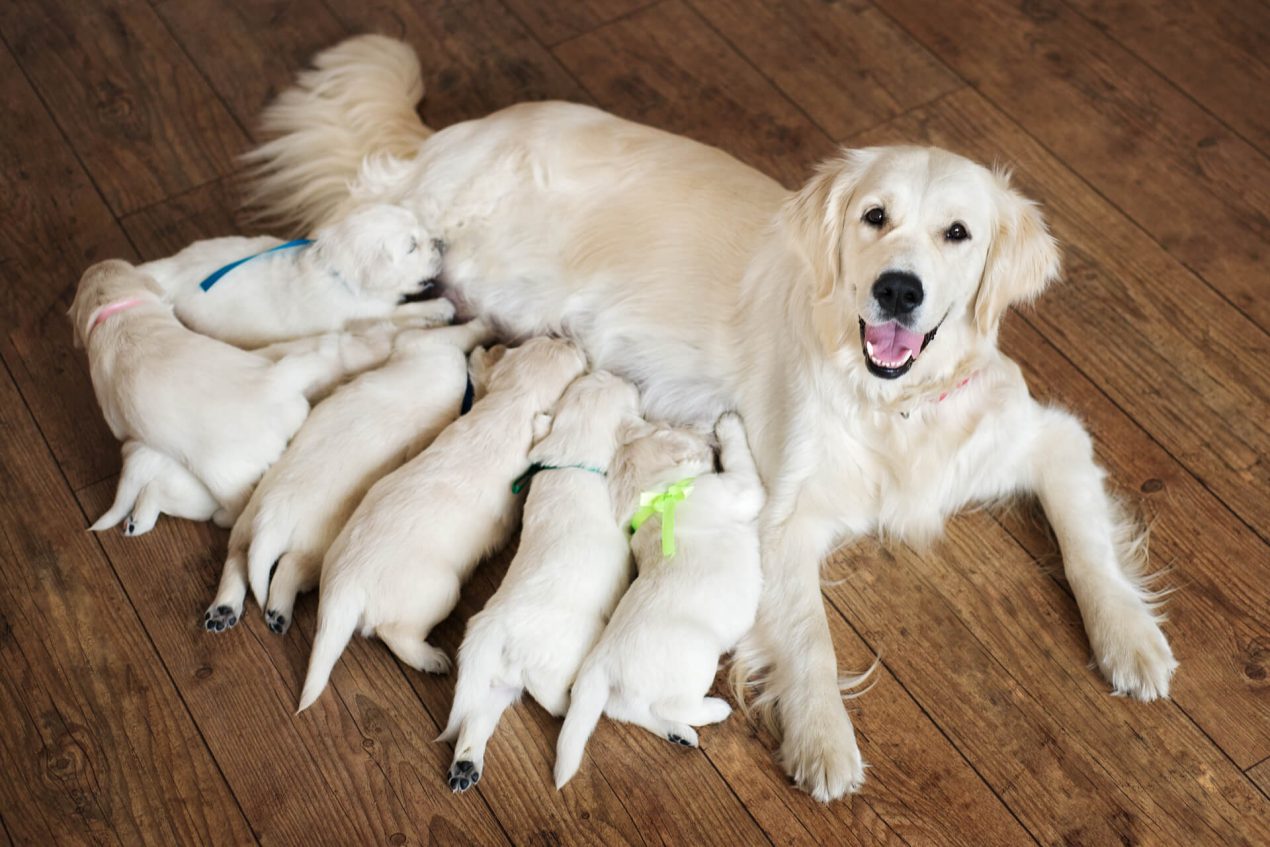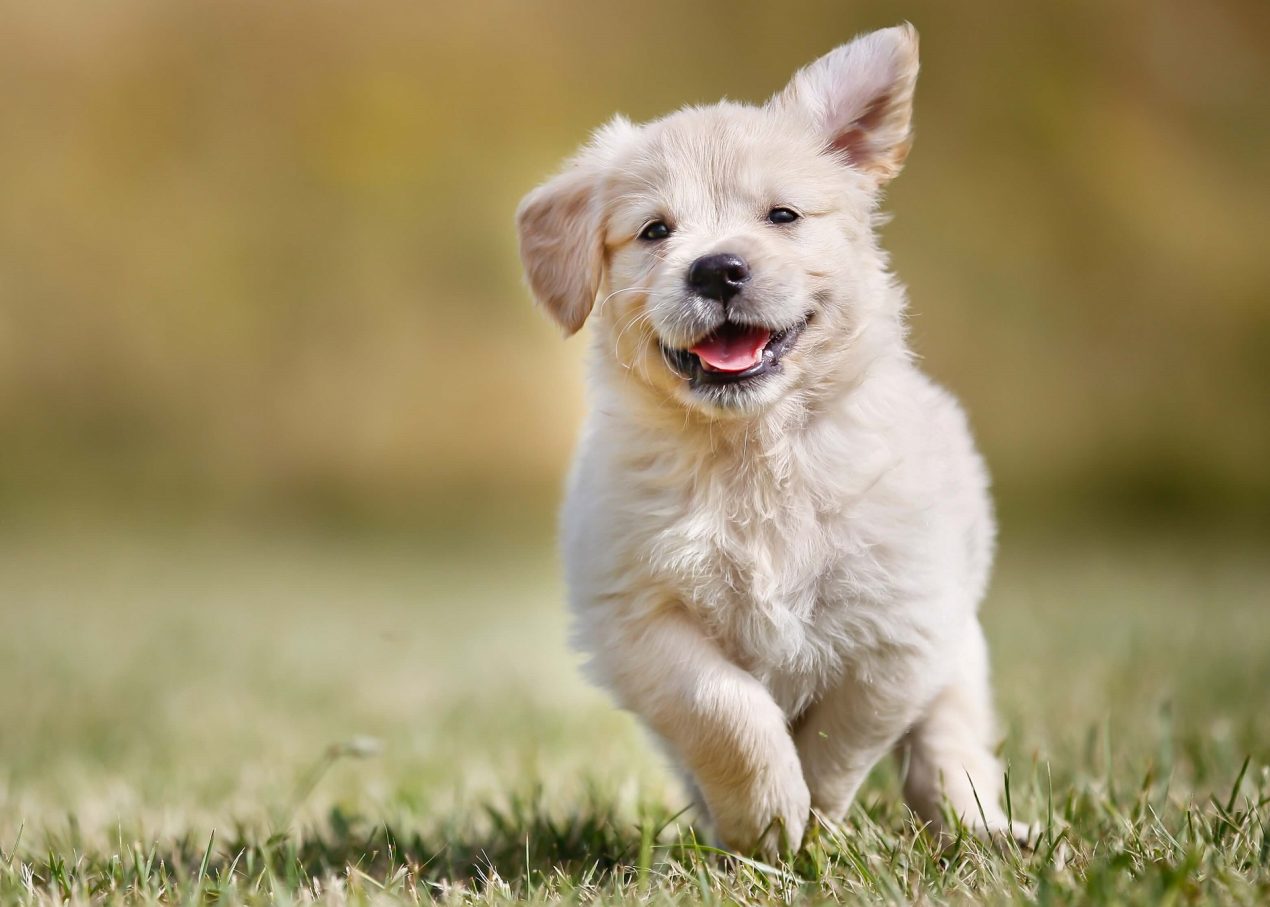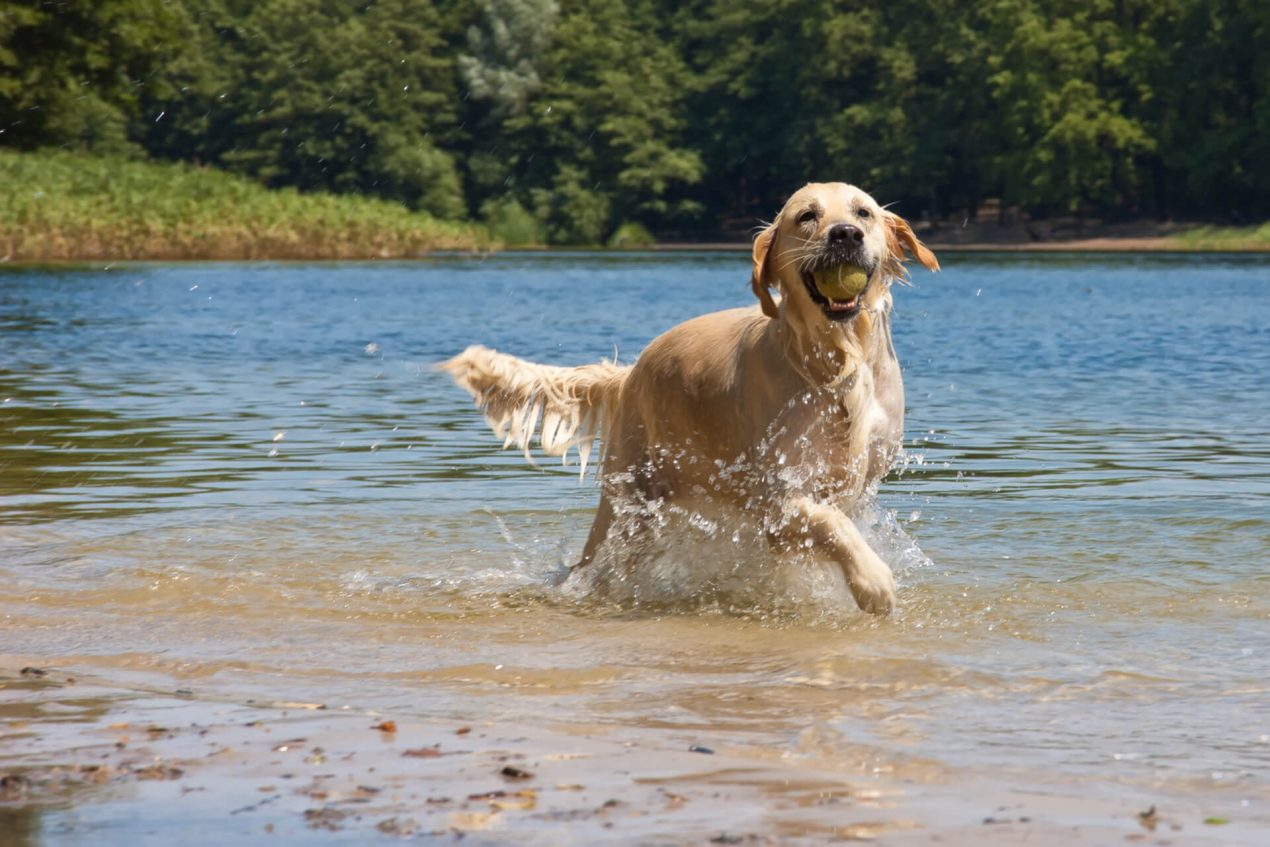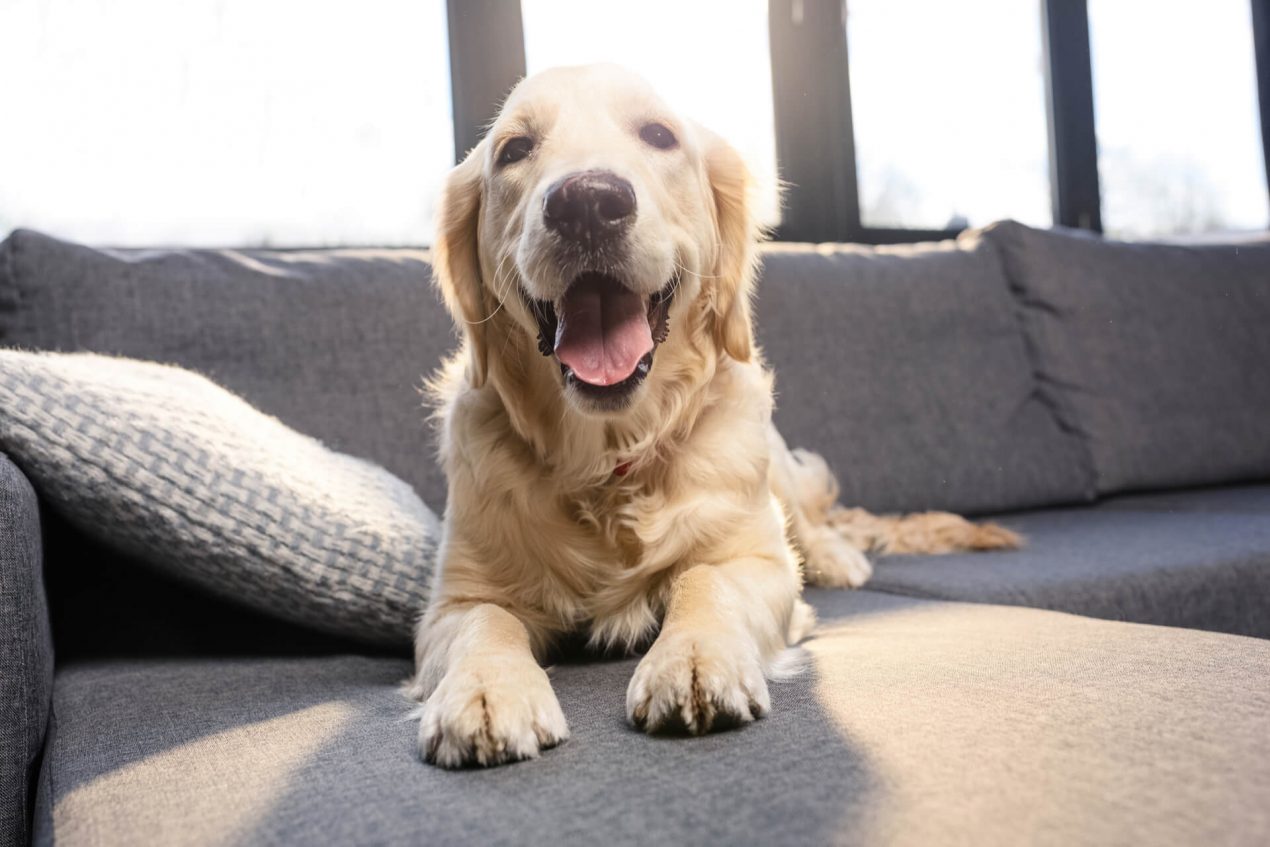With their golden long fur, friendly nature, and loyal gaze, Golden Retrievers have become one of the most popular pets in the United States. Here you’ll find everything you’ve ever wanted to know about this popular dog breed.
- History of the Golden Retriever
- Appearance of the Golden Retriever
- Traits and Characteristics
- How to Care for a Golden Retriever?
- Development and Training of the Puppy
- Activities with a Golden Retriever
- Health and Hereditary Diseases
- Grooming a Golden Retriever
- Interesting and Notable Facts about the Golden Retriever
History of the Golden Retriever
In the mid-19th century, it was popular among the Scottish nobility to hunt ducks and other game birds. Occasionally, the valuable prey would end up in rivers or lakes, which was unavoidable. Hence, they needed a reliable dog that could retrieve the game to its owner in any terrain without damaging or eating it.
They needed an obedient dog with a “soft” mouth and a good sense of smell. So, Scottish Sir Dudley Majoribanks took it upon himself to breed the perfect retriever. In 1865, he acquired the yellow retriever Nous and the golden water spaniel Bell and began breeding. The retriever breeding was successful, and by the end of the 19th century, his new breed became widely known in Britain. Eventually, it was recognized by the Fédération Cynologique Internationale as a separate British dog breed. The breed belongs to the FCI Group 8, Section 1, and thus to the retrieving dogs.
The American Kennel Club recognized the breed in 1932. Today, the Golden Retriever is the second most popular breed in the United States of America. The Golden Retriever should not be confused with the Labrador Retriever. The Labrador has significantly shorter fur and can be yellow, golden, brown, or black.
Breed Overview
GROUP: Sporting
HEIGHT: 23 to 24 inches (males); 21.5 to 22.5 inches (females)
WEIGHT: 65 to 75 pounds (males); 55 to 65 pounds (females)
COAT: Medium-length double coat
COAT COLOR: Light to dark gold
LIFE SPAN: 10 to 12 years
TEMPERAMENT: Trustworthy, intelligent, playful, energetic
HYPOALLERGENIC: No
ORIGIN: United Kingdom, Scotland
Appearance of the Golden Retriever
The Golden Retriever is one of the most popular dog breeds worldwide and is highly regarded as a family dog. Its appearance is characteristic and appealing. Due to its medium size, robust musculature, and friendly expression, the Golden Retriever exudes a special charm.
The fur color of the Golden Retriever can be found in various shades of gold to cream. The dense and water-repellent fur is of medium length with a smooth or slightly wavy texture. Due to this special coat, the Golden Retriever requires regular grooming to prevent matting and maintain the dog’s beautiful appearance.
| Affection Level | High |
| Friendliness | High |
| Kid-Friendly | High |
| Pet-Friendly | High |
| Exercise Needs | High |
| Playfulness | High |
| Energy Level | High |
| Trainability | High |
| Intelligence | High |
| Tendency to Bark | Medium |
| Amount of Shedding | High |
Traits and Characteristics
The purebred Golden Retriever was bred as an obedient and easily trainable dog so that it could be easily used in hunting. Because of this original purpose, the breed allegedly shows a “will to please” its owner. This means that the dog is devoted, and affectionate. In terms of temperament, Retrievers are not fearful or frantic but are cheerful and lively in every situation. They are extremely patient, adaptable, and nothing can disturb their calm demeanor.
The Retriever quickly gets excited to play and is often very active and playful even as an old dog. They are strongly attached to their human family and would prefer to be everywhere with them. With their friendly demeanor towards strangers, this is not a problem with a well-trained dog. Likewise, they are extremely intelligent and learn new commands and games with great enthusiasm.
Bad weather doesn’t faze them, and they need their daily exercise even in rain and storm. A Golden Retriever is therefore particularly suitable for families who enjoy engaging in sports with them and like to go hiking. Due to their sociability, they feel most comfortable in a family with a lot of social interaction. Golden Retrievers also get along well with other dogs, and they can be great as second dogs.
How to Care for a Golden Retriever?
Before you decide to get a Golden Retriever, you need to consider a few things. Training him is relatively easy compared to other breeds, making the Goldie an ideal “beginner dog.” However, before purchasing, you should ask yourself if you are ready to commit to a dog for a long time. The Golden Retriever has a relatively long life expectancy of 10-14 years.
During this time, daily exercise, grooming, and constant care for the dog should not be a problem. Due to their strong attachment to people, Golden Retrievers are not suitable for kennel keeping and do not like being left alone at home. Ideally, you should keep your dog in a house with a garden.
The costs of acquiring a Golden Retriever vary greatly. The price can range from $200 to over $1000 depending on whether it is purebred, a puppy, or an adult. If you do not want to buy a puppy, you should look into the Golden Retriever Club of America. Here, experienced dog owners are sought to take in a retriever from poor conditions and give them a new home.

Development and Training of the Puppy
When you pick up your Golden Retriever puppy from the breeder, it is usually 8-12 weeks old. This is the right time for the little one to get used to its new pack and learn to live together with humans and dogs. Golden Retriever females reach sexual maturity around the sixth month of life, and males reach it around ten months. Physically, the dogs are fully grown at around two to two and a half years old.
It may be difficult to start training the cute puppy immediately after purchase, but it is necessary even for a Golden Retriever. Although the breed is relatively easy to train, no dog comes perfectly trained into the world. The Golden Retriever learns at a rapid pace but also responds quickly to inconsistency. You must not allow your puppy to do anything that it should not do as an adult dog.
Puppy training includes basic commands like “sit,” “down,” and “come.” Positive reinforcement and reward systems help motivate the puppy and teach it the desired behaviors. Consistent yet gentle training lays the foundation for a harmonious relationship between human and dog.

Activities with a Golden Retriever
Due to its unique character, the Golden Retriever is excellent as a family dog. It gets along well with children and wants to be a full member of the family. However, it should not be forgotten that it was originally bred as a hunting dog to work outdoors with its owner. Long walks and varied training sessions are therefore part of the daily routine with a Golden Retriever.
The energetic dog needs at least a few hours a day of physical activities and mental stimulation exercises. While dummy training and fetching games are particularly suitable, it also enjoys agility training, mountain hiking, or other sports. The main thing is that its owner engages with it sufficiently. Since almost all Golden Retrievers love to splash around in the water, trips to lakes and streams should also be included in the program.

Health and Hereditary Diseases
The Golden Retriever is also one of the dogs whose need for exercise is often underestimated, which can quickly lead to overweight. It is not possible to determine exactly how much food a Golden Retriever needs. This can vary greatly depending on size and activity level. A well-fed, sporty dog should weigh between 30 and 40 kilograms.
Like many breeds, this breed also has certain hereditary diseases to watch out for. One of the most common hereditary diseases in Golden Retrievers is hip dysplasia, which involves a malformation of the hip joint. This can lead to pain and mobility restrictions. Therefore, it is advisable to have the parent animals examined for hip dysplasia before breeding to minimize the risk of hereditary predispositions.
Furthermore, Golden Retrievers can frequently suffer from elbow dysplasia, which involves a malformation of the elbow joint, leading to lameness and pain. Golden Retrievers can also suffer from eye diseases such as cataracts (cloudiness of the lens) or progressive retinal atrophy (PRA). These conditions can lead to vision loss and should be regularly monitored by a veterinarian.
Grooming a Golden Retriever
Taking care of a Golden Retriever requires attention and dedication. Regular brushing of the coat is necessary to remove loose hair and prevent matting. It is advisable to regularly check and clean the ears to avoid possible infections. Dental hygiene should not be neglected, so regular tooth brushing is important.
The Golden Retriever is an active breed and requires sufficient exercise to stay fit and healthy. Daily walks, playtimes, and mental challenges are crucial for its well-being. Additionally, a balanced diet is essential to prevent obesity and promote the dog’s health.
Golden Retrievers as Helpers in Everyday Life:
Apart from the usual activities for dogs, the Golden Retriever is also excellent as a guide dog or therapy dog. A therapy dog must not be insecure or fearful and must have a patient, calm nature. Due to its friendly and empathetic nature, the Goldie excels in training in one of these areas with great enthusiasm. It is often trained as a search and rescue dog or for person or explosive detection due to its strong affinity for water, making it also excellent for water rescue operations.

Interesting and Notable Facts about the Golden Retriever
Their significant presence in film and television also contributes significantly to the breed’s popularity. One of the best examples of this is the well-known Golden Retriever Air Buddy, who appeared in numerous film productions in the 1990s. He gained fame in the role of “Air Bud” in the film “Air Bud – Champion on Four Paws” and as “Comet” in the television series “Full House.” Buddy was found as a stray in the Sierra Kevin DiCicco area in the summer of 1989 and was adopted. He subsequently learned several sports such as basketball, baseball, chess, and more, which he showcased in his films.
Do you also have a Golden Retriever or are you planning to get one soon? Share with me in the comments what makes the Goldie so special!


